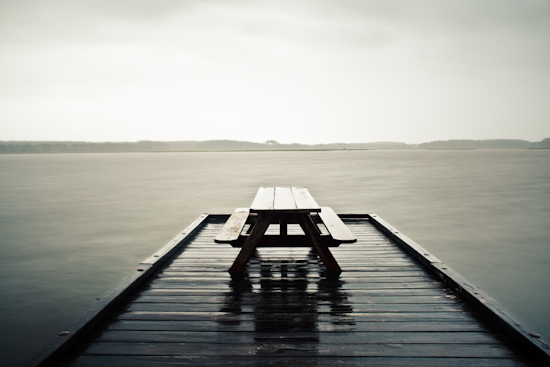I was at Assateague Island one weekend trying to shoot some video footage of the beach and things. But as soon as I've unpacked my gear, the wind was blowing 30-40 mph and started to rain. I went out to the beach anyway and got my face sand blasted. After about 20 minutes, I headed back to my car.
Shot this from inside of my car. The water was coating the window distorting the view, giving it an impressionistic look. It's not a photoshop filter. I used a small f-stop and focused on the window, not the scene. This allowed me to get the detail of the wavy texture.
Tried to wait out the rain but it was not slowing down. So I decided to head out to a different beach, hoping that the rain would slow down by the time I get there. I was wrong and the GPS navigation system was wrong too. I got lost.
But I ran into this! It was some kind of nature preserve by the coast. It was still raining hard but the long shutter speed hid the drops. I used a ND filter to slow the shutter speed so that I can get the water very smooth. I think it was like 8 sec.
Rocks and waves with slow shutter always look nice. Sure its been done before...I would have like to drag out the shutter more, like 30 sec or a full minute. But I didn't want to stack 3 ND filters. Especially when they were dripping wet. After this session I went out and got a 7 stop multi-coated ND. Now I don't have to stack filters, losing image quality.
I was all ready to go home when I saw this. Can you imagine having lunch there? This was too cool for me to pass up. I was only able to grab about 2 shots because the wind was blowing the rain drops between the stacked filters, blurring the image. I was afraid that the wind would shake the tripod, but my trusty Bogen held steady.
The day started out pretty miserably, with the weather and getting lost. but at least I didn't come home empty handed.
These poor horses. Their posture pretty much sums up how I was feeling in the rain.
These are wild horses on the Assateague Island. Few hundred years ago, a Spanish ship loaded with horses sunk near by. The good swimmers made it to this island and started a new life as tourist attraction. Poor horses.





Do you own rain gear for your camera? I have something similar to a plastic bag and it isnt sufficient to work the camera in torrential downpour. Your recommendation is greatly appreciated!
ReplyDeleteMimi
According to Canon, the 5DMKII is somewhat sealed. I'm not the most careful person when it comes to equipments. I've put my equipment through some less than ideal environments and hasn't given me any issues yet.
ReplyDeleteI was using a hand towel on top of the camera with plastic stapled on one side. I like it better than a bag because the towel somewhat absorbs the water, not repel it like a plastic bag does. with a plastic bag any water that gets inside the bag (from your hands, mostly) will remain.
The plastic on top repels the water and the towel next to the camera absorbs the water. It works well but not as well as a real rain gear. I think the setup that I use is a good balance between cost and effectiveness.